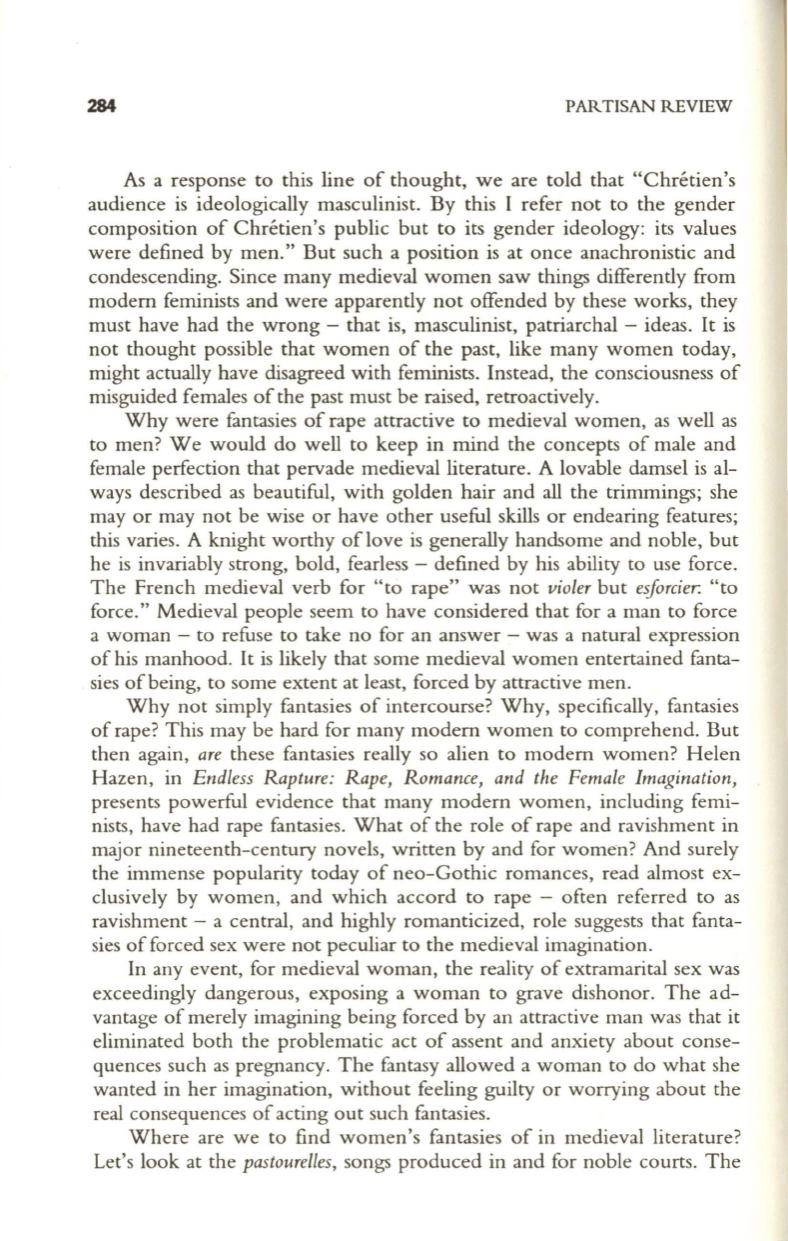
284
PARTISAN REVIEW
As a response to this line of thought, we are told that "Chretien's
audience is ideologically masculinist. By this I refer not to the gender
composition of Chretien's public but to its gender ideology: its values
were defined by men." But such a position is at once anachronistic and
condescending. Since many medieval women saw things differently from
modern feminists and were apparently not offended by these works, they
must have had the wrong - that is, masculinist, patriarchal - ideas.
It
is
not thought possible that women of the past, like many women today,
might actually have disagreed with feminists. Instead, the consciousness of
misguided females of the past must be raised, retroactively.
Why were fantasies of rape attractive to medieval women, as well as
to men? We would do well to keep in mind the concepts of male and
female perfection that pervade medieval literature. A lovable damsel is al–
ways described as beautiful, with golden hair and all the trimmings; she
mayor may not be wise or have other useful skills or endearing features;
this varies. A knight worthy of love is generally handsome and noble, but
he is invariably strong, bold, fearless - defined by his ability to use force.
The French medieval verb for "to rape" was not
violer
but
esforcier.
"to
force." Medieval people seem to have considered that for a man to force
a woman - to refuse to take no for an answer - was a natural expression
of his manhood.
It
is likely that some medieval women entertained fanta–
sies of being, to some extent at least, forced by attractive men.
Why not simply fantasies of intercourse? Why, specifically, fantasies
of rape? This may be hard for many modern women to comprehend. But
then again,
are
these fantasies really so alien to modern women? Helen
Hazen, in
Endless Rapture: Rape, Romance, and the Female Imagination,
presents powerful evidence that many modern women, including femi–
nists, have had rape fantasies . What of the role of rape and ravishment in
major nineteenth-century novels, written by and for women? And surely
the immense popularity today of neo-Gothic romances, read almost ex–
clusively by women, and which accord to rape - often referred to as
ravishment - a central, and highly romanticized, role suggests that fanta–
sies of forced sex were not peculiar to the medieval imagination.
In
any event, for medieval woman, the reality of extramarital sex was
exceedingly dangerous, exposing a woman to grave dishonor. The ad–
vantage of merely imagining being forced by an attractive man was that it
eliminated both the problematic act of assent and anxiety about conse–
quences such as pregnancy. The fantasy allowed a woman to do what she
wanted in her imagination, without feeling guilty or worrying about the
real consequences of acting out such fantasies.
Where are we to find women's fantasies of in medieval literature?
Let's look at the
pastourelles,
songs produced in and for noble courts. The


